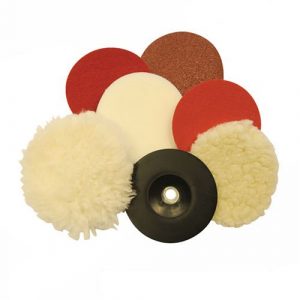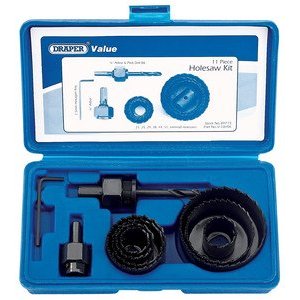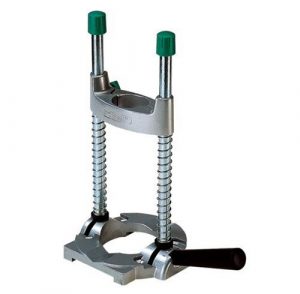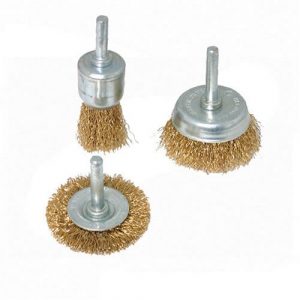Your trusty power drill is useful for far more than just drilling holes in timber or walls. With the addition of a few accessories it could soon be helping you polish your car, stir paint or even pump water. Note: A variable speed drill is more suitable for many of these drill accessories.
 Wire Brushes
Wire Brushes
These cheap but useful drill accessories are available in a couple of different styles (cup and wheel) and a variety of sizes. The simplest type are attached to a metal spindle, but you can also buy sets with a spindle and removable heads for different areas and surfaces. The different sizes and shapes should allow you to clean rust and dirt easily from even tight corners.
Sanding Discs
 Great for quickly sanding flat areas of wood if you don’t own a power sander. Sanding discs comprise a stuff rubber backing dics with a spindle and removable discs of sandpaper which are attached using a small screw and nut or wingnut. As with any rotary sander, sanding disc attachments for your drill can leave circular swirl marks on the surface of the wood if you use paper that is too coarse. If you have a large area to sand, it is usually best to buy, borrow or hire a belt sander.
Great for quickly sanding flat areas of wood if you don’t own a power sander. Sanding discs comprise a stuff rubber backing dics with a spindle and removable discs of sandpaper which are attached using a small screw and nut or wingnut. As with any rotary sander, sanding disc attachments for your drill can leave circular swirl marks on the surface of the wood if you use paper that is too coarse. If you have a large area to sand, it is usually best to buy, borrow or hire a belt sander.
Polishing Pads
Attaching to your drill in a similar way to sanding discs, polishing pads are great for getting a showroom shine on your car or even your furniture. The pads are usually lambswool and attach to the pad using simple elasticated grips.
Paint Mixer
These plastic or steel drill attachments usually take the form of a long pole with what looks like the head of a potato masher on the end (designs do vary). Twisted blades on the sides of the head will, when rotated, do a very good job of mixing paint or other liquids. As with most of these accessories, a paint mixer is best used on a drill with variable speed settings. In this case, a slower spin speed will help to avoid splashing.
Light-Duty Pump
This very simple yet effective pump accessory can be used to drain ponds or clean up after a plumbing disaster. The pump itself is a simple impeller (the drill drives the impeller blades) with connections for a length of hose at each end. An inexpensive but useful addition to your emergency plumbing kit, just make sure you follow the manufacturers instructions on drill speeds, etc.
Hole Saws
 A Hole Saw (also known as a Hole Cutter) is a cylindrical saw, usually with a drill bit at its centre. The drill bit acts as a guide (it protrudes out past the end of the saw blade) whilst the cutting edge rotates around it to cut out a large section of material. Designed to be fitted into a power drill, and used to cut relatively thin material, hole saws are available in a wide range of diameters, from 6mm up to about 130mm. The length of the cylinder is usually no longer than about 300mm. Hole Saws should be used when the hole you need to make is larger than the largest available drill bits (around 38mm).
A Hole Saw (also known as a Hole Cutter) is a cylindrical saw, usually with a drill bit at its centre. The drill bit acts as a guide (it protrudes out past the end of the saw blade) whilst the cutting edge rotates around it to cut out a large section of material. Designed to be fitted into a power drill, and used to cut relatively thin material, hole saws are available in a wide range of diameters, from 6mm up to about 130mm. The length of the cylinder is usually no longer than about 300mm. Hole Saws should be used when the hole you need to make is larger than the largest available drill bits (around 38mm).
The cutting edge of the saw will either be formed of metal teeth or will have industrial diamonds embedded into it. Metal toothed hole saws are designed to cut wood and the diamond toothed saw is for cutting stone or concrete. Hole saws are sold both individually and, more often, in sets containing several different sizes. You can buy a standard hole saw set for as little as £5.
Draper DIY Series 16645 11-Piece Hole Saw Kit
Bench-Mounted Drill Stand
 If you do a lot of woodwork, a bench-mounted drill stand is a very useful bit of kit. Comprising a simple clamp to hold the drill, connected to a baseplate (for clamping to a bench or the material itself) by two sprung rods.
If you do a lot of woodwork, a bench-mounted drill stand is a very useful bit of kit. Comprising a simple clamp to hold the drill, connected to a baseplate (for clamping to a bench or the material itself) by two sprung rods.
Once the drill is properly inserted and the stand is clamped down, you will be able to produce perfect 90 degree holes. The sprung rods also make it easier to apply even pressure when drilling.

 Wire Brushes
Wire Brushes




